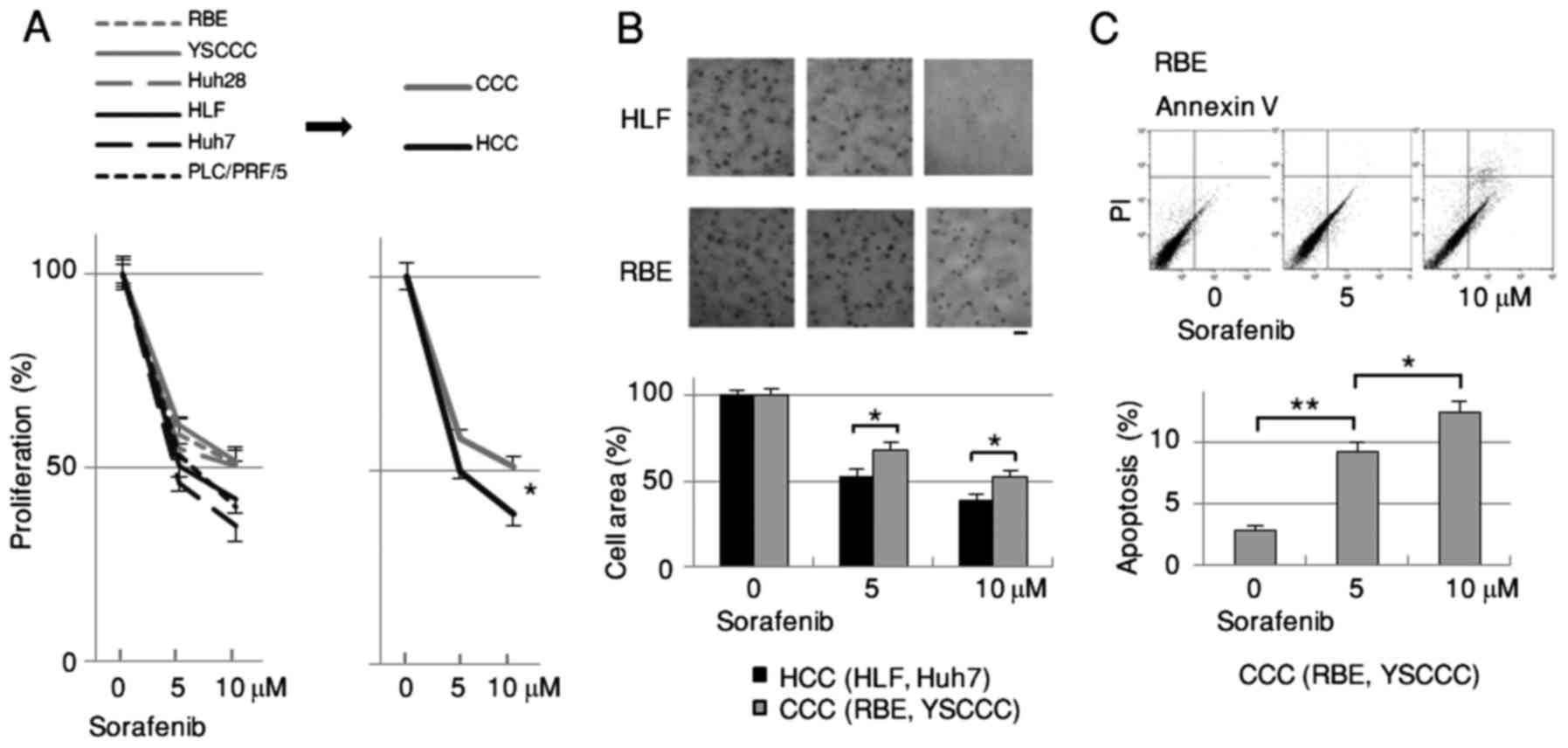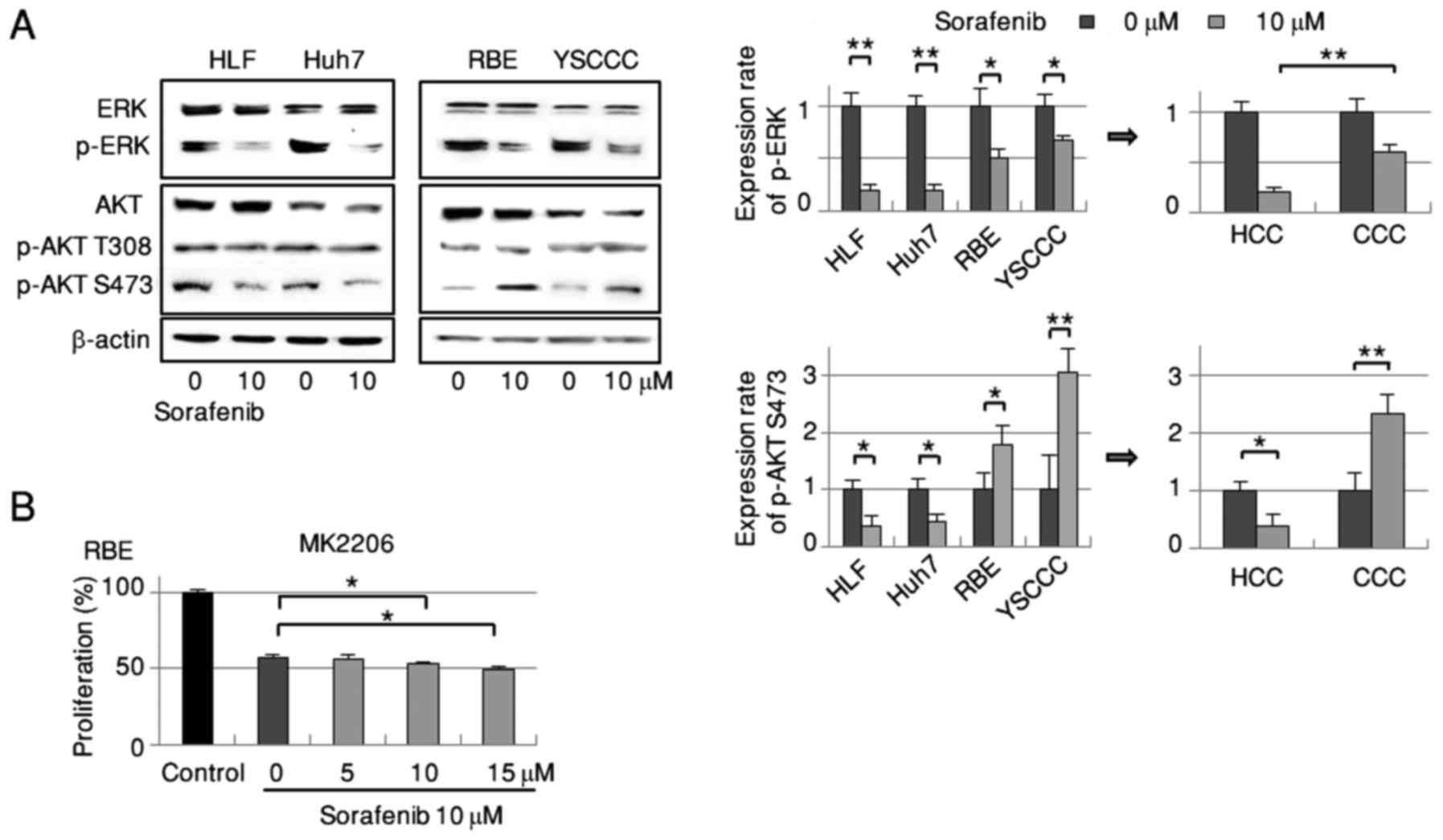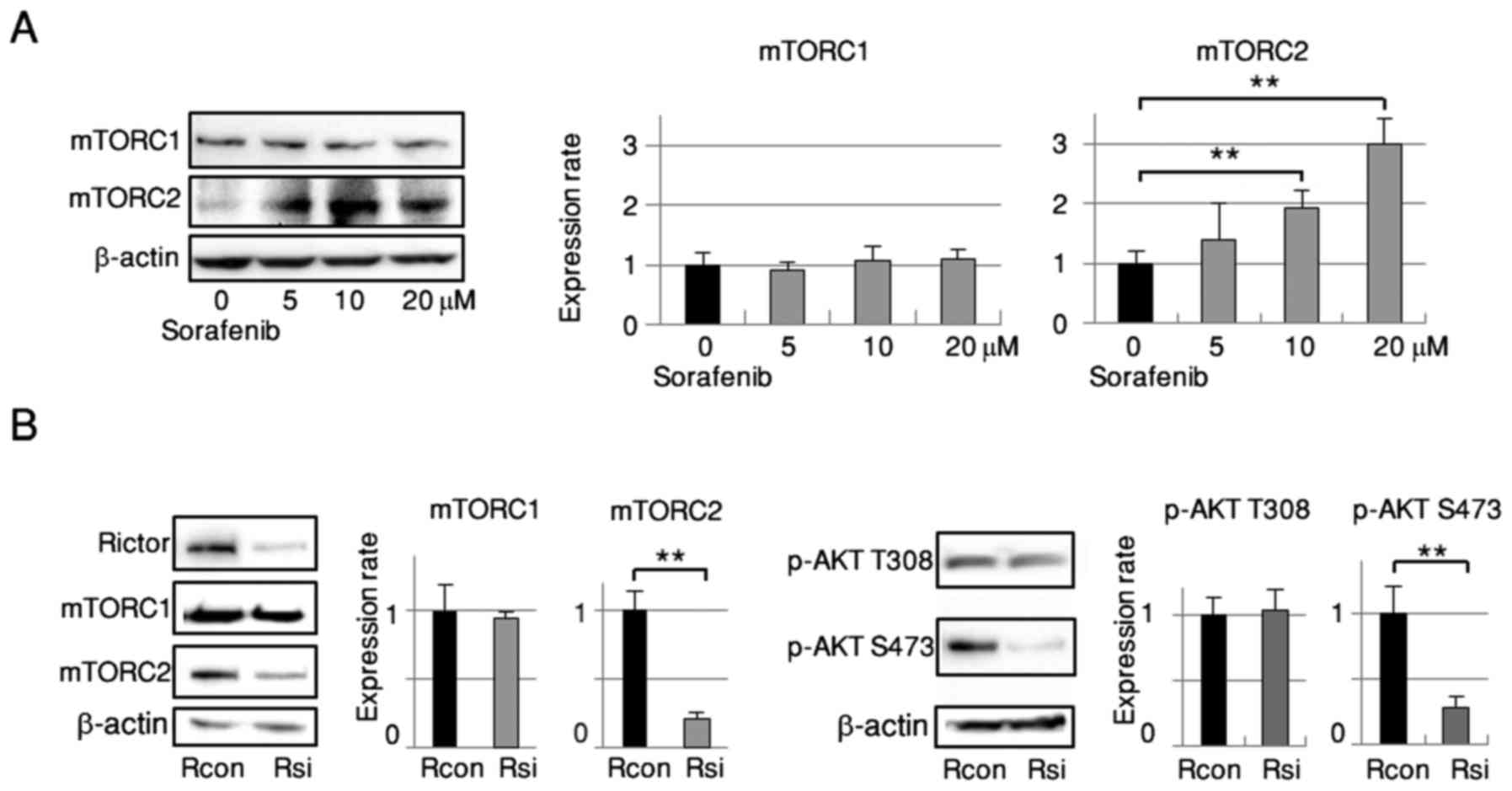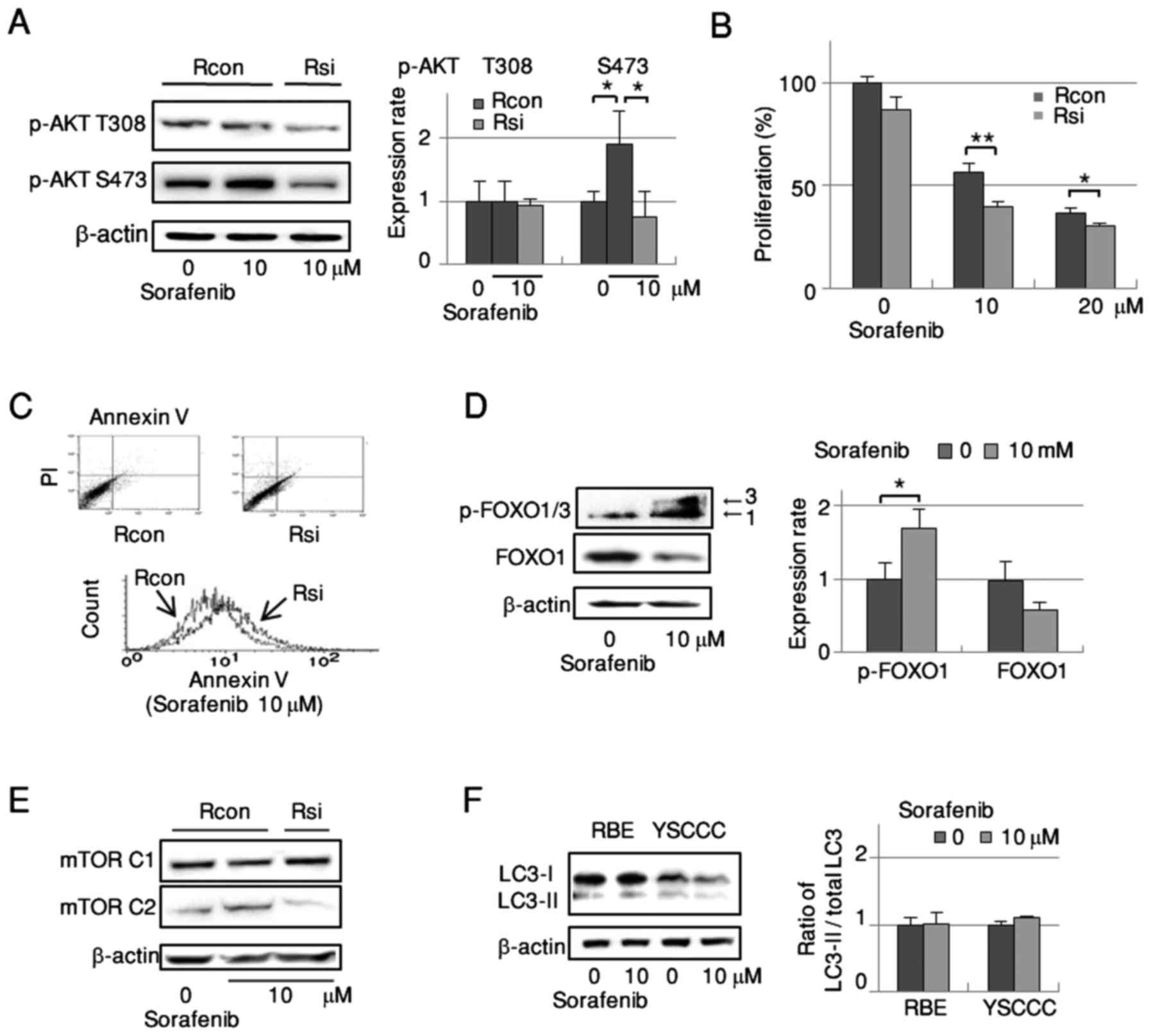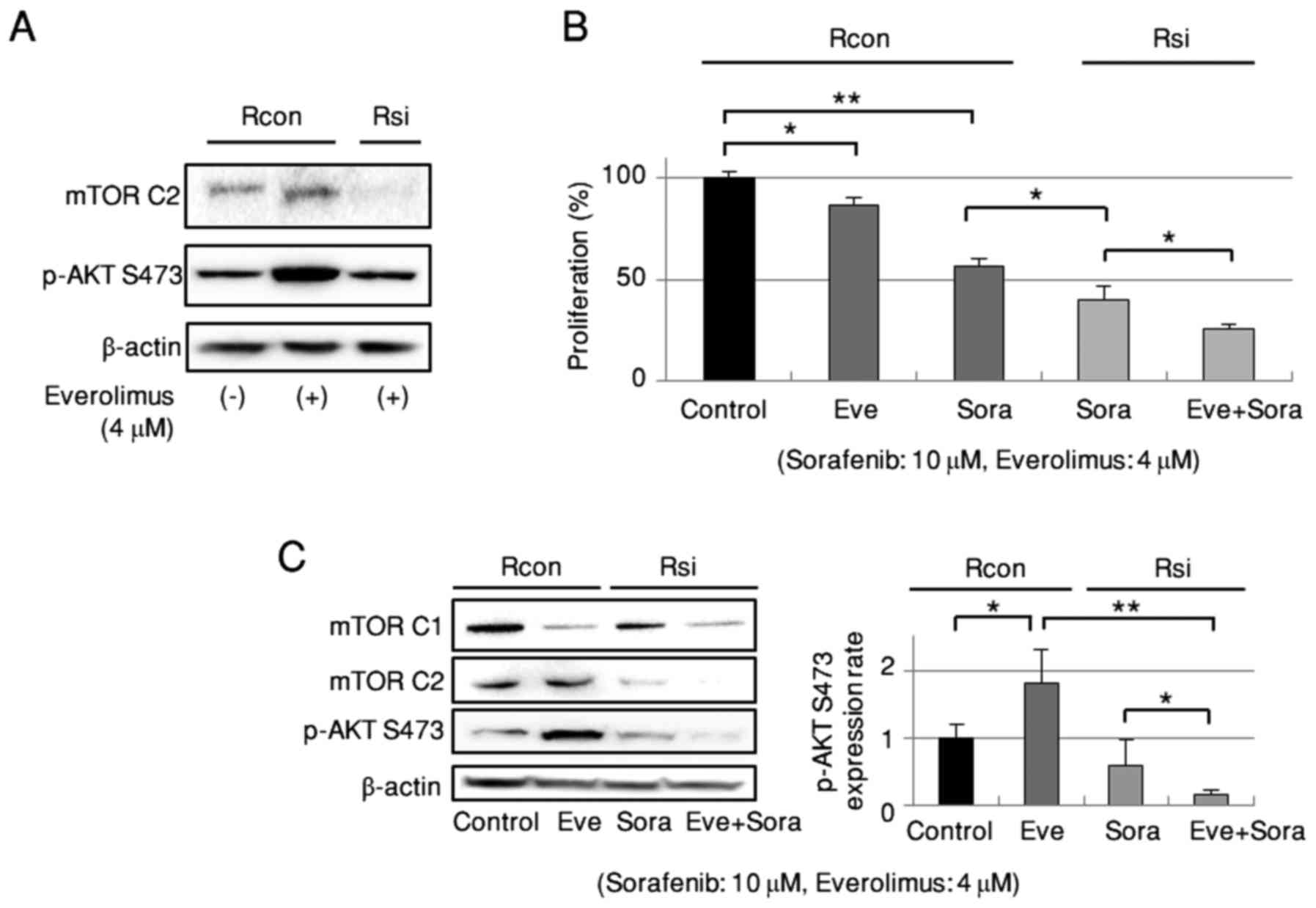Survival pathway of cholangiocarcinoma via AKT/mTOR signaling to escape RAF/MEK/ERK pathway inhibition by sorafenib
- Authors:
- Published online on: December 13, 2017 https://doi.org/10.3892/or.2017.6153
- Pages: 843-850
Abstract
Introduction
Originating in the epithelial cells lining the biliary tree, cholangiocarcinoma (CCC) is an aggressive malignancy with a poor prognosis. CCC represents 10–15% of total hepatobiliary tumors (1) and its incidence and mortality are continuously increasing worldwide (2). Although the 5-year survival rate of patients receiving curative resection for CCC is 30–40%, individuals with unresectable CCC generally survive less than 12 months after diagnosis (3). Thus, the establishment of effective clinical molecular markers for early diagnosis and targeted molecular therapies are urgently needed for CCC.
Among the numerous inhibitors of tyrosine kinase, sorafenib (BAY 43-9006) has attracted considerable attention. Sorafenib inhibited Raf-1 (4) and BRAF (5), both members of the RAF/mitogen-activated protein kinase (MEK)/extracellular signal-related kinase (ERK) signaling pathway, and suppressed the proliferation and growth of several human tumor cell lines and xenograft models. The drug also exhibited significant activity against multiple receptor tyrosine kinases involved in tumor progression, including vascular endothelial growth factor receptor (VEGFR)-2, VEGFR-3, c-KIT, Flt-3, and platelet-derived growth factor receptor β (5).
Sorafenib is effective for hepatocellular carcinoma (HCC) by virtue of prolonged median survival in advanced-stage patients (6). The effects of sorafenib, however, are far less understood for CCC. Sorafenib exerted low activity in a phase II CCC trial (7), and not even a combination of sorafenib and erlotinib could exhibit clinical activity in patients with biliary cancers in a phase II trial (8). Thus, sorafenib is the first molecular-targeted therapy to be approved for HCC, but not for CCC, despite the fact that the liver and bile duct are derived from the same embryological origin.
The in vitro antitumor activity of sorafenib in human CCC has been assessed in several signaling pathways. Blockage of the MAPK pathway by sorafenib inhibited cell proliferation through cell cycle arrest (9), and sorafenib accelerated STAT3 dephosphorylation and induced TRAIL-mediated apoptosis (10).
Recently, the phosphoinositide 3-kinase (PI3K)/AKT/mammalian target of rapamycin (mTOR) pathway was implicated in sorafenib-resistant HCC, whereby constitutive activation of the mTOR pathway was present in drug-resistant HCC cells (11). Increased AKT phosphorylation was also witnessed in established sorafenib-resistant HCC cells (12). We therefore focused our attention on the AKT/mTOR pathway as a CCC escape mechanism from RAF/MEK/ERK-mediated cell death under sorafenib based on comparisons of HCC and CCC.
Two forms of mTOR protein complexes exist. mTORC1, defined by the Raptor scaffolding protein (13), is sensitive to rapamycin. Activation of mTORC1 triggers mitochondrial oxidative metabolism and lipogenesis, which are critically important in tumorigenesis (14). mTORC1 is also a negative regulator of autophagy (15). Characterized by Rictor, mTORC2 phosphorylates AKT on Ser 473, regulates forkhead box protein (FOXO) activation, and modifies the actin cytoskeleton with oaxilin and Rho GTPases (16). Inhibition of mTORC2 by Rictor disruption decreases AKT-dependent tumor progression in lapatinib-resistant HER2-amplified breast cancers (17). Accordingly, we examined the influence of sorafenib on the AKT/mTOR pathway to observe how dissociation of the mTORC2 component by Rictor knockdown altered this pathway in CCC. Since activated mTORC1 has been reported in CCC, we also combined everolimus with sorafenib to simultaneously suppress mTORC1 under mTORC2 disassembly.
Materials and methods
Cell lines and culture
The human HCC cell lines HLF, Huh7, and PLC/PRF/5 and human intrahepatic CCC cell line Huh28 were obtained from the Japanese Collection of Research Bioresources (JCRB) Cell Bank (Osaka, Japan). The human intrahepatic CCC cell lines RBE and YSCCC were procured from the RIKEN Cell Bank (Ibaraki, Japan). HCC cells were maintained in Dulbecco's modified Eagle's medium and CCC cells were maintained in RPMI-1640. All cultures were supplemented with 10% fetal bovine serum (FBS), 100 U/ml penicillin, and 100 µg/ml streptomycin in a humidified atmosphere of 5% CO2 at 37°C.
Analysis of cell proliferation and anchorage-independent growth assay
The MTT assay was used for analyzing cell proliferation. At 24 h after inoculation of HCC and CCC cells, DMSO (0.1% in culture medium) or 5 or 10 µM sorafenib were administered and the cells were cultured for an additional 24 h. Ten microliters WST-1 reagent (Roche Diagnostics GmbH, Mannheim, Germany) was added to each well and the absorbance was assessed at 450 nm after 1 h of incubation using an Epoch microplate reader (BioTek Instruments, Inc., Winooski, VT, USA). We performed anchorage-independent assays according to a previously described method (18). Briefly, cells were mixed in 0.36% agar-containing medium with 10% FBS containing DMSO or 5 or 10 µM sorafenib. The mixture was placed on a bed of 0.72% agar-containing medium with 10% FBS and DMSO or 5 or 10 µM sorafenib in 35-mm dishes. Three weeks after the inoculation, the colony areas were assessed using NIH ImageJ software (Rockville, MD, USA).
Apoptosis assay
One day after inoculation, RBE cells were treated with DMSO or 5 or 10 µM sorafenib for 24 h and cellular apoptosis was examined by Annexin V and propidium iodide (PI) staining using an Annexin V-FITC Apoptosis kit (BioVision, Inc., Milpitas, CA, USA) according to the manufacturer's protocol. Following staining, the cells were analyzed using flow cytometry (FACS) on a FACSCalibur device (BD Biosciences, Franklin Lakes, NJ, USA).
Western blot analysis
Cells were lysed in lysis buffer containing 50 mM Tris-HCl pH 7.4, 150 mM NaCl, 1% Triton X-100, 1% sodium deoxycholate, 0.1% SDS, 1X EDTA-free proteinase inhibitor cocktail and 1X phosphatase inhibitor cocktail (both from Roche Diagnostics GmbH) for 15 min at 4°C. The lysates were separated by 15% SDS-PAGE and the proteins were transferred onto nitrocellulose membranes. After blocking with 5% skim milk for 1 h, the membranes were incubated with primary antibodies overnight at 4°C, and then secondary antibodies conjugated with horseradish peroxidase were applied for 1 h. Immune complexes were developed with ECL Select™ Western blotting detection reagent (Amersham, GE Healthcare Life Sciences, Chicago, IL USA). The results were photographed with a Molecular Imager ChemiDoc XRS device (Bio-Rad Laboratories, Inc., Hercules, CA, USA). The integrated density of the immunoblots was analyzed by Image Lab Software (Bio-Rad Laboratories, Inc.) and results were expressed as a percentage of the immunoblots of the internal control, β-actin. The anti-human antibodies used were as follows: rabbit monoclonal antibodies: ERK (cat. no. 4695), p-ERK (cat. no. 4376), AKT (cat. no. 4691), 0020P-AKT Thr 308 (cat. no. 2965), p-AKT Ser473 (cat. no. 4060), p-mTOR s2448 (cat. no. 5536), Rictor (cat. no. 9476) and FOXO1 (cat. no. 2880) (all from Cell Signaling Technology, Inc., Danvers, MA, USA); rabbit polyclonal antibodies: p-mTOR s2481 (cat. no. 2974), p-FOXO1/3 (cat. no. 9464) (Cell Signaling Technology, Inc.), LC3 (cat. no. PM036; MBL, Nagoya, Japan); and mouse monoclonal antibody: β-actin (cat. no. A5441; Sigma-Aldrich, St. Louis, MO, USA). The anti-β-actin antibody was used at a 1:3,000 dilution and the other antibodies were used at a 1:1,000 dilution.
Knockdown of Rictor via siRNA transfection for disassembly of the mTORC2 complex in RBE cells
Silencer Select siRNA was purchased from Life Technologies/Thermo Fisher Scientific (Carlsbad, CA, USA) and modified to target human Rictor by reverse transfection (19). Either 10 µM Silencer Select non-targeting negative control or 10 µM Rictor siRNA was mixed with Lipofectamine RNAiMAX (Life Technologies/Thermo Fisher Scientific) according to the manufacturer's instructions and added to 35-mm tissue culture plates. The cells were then plated onto siRNA/Lipofectamine RNAiMAX complexes at a density of 1×105 cells/well in RPMI-1640 containing 5 mM glucose and 10% FBS. At 48 h after transfection, Rictor knockdown was confirmed by western blotting and the cells were subjected to ensuing experiments.
Statistical analysis
Statistical significance was evaluated using the Student's t-test on the data of 3–6 experiments for each assay. P<0.05 was accepted as statistically significant. All values were expressed as the mean ± standard error of the mean.
Results
Sorafenib inhibits growth significantly less in CCC than in HCC
Since sorafenib is the first molecular-targeted drug approved for HCC but not for CCC, we compared its effects on the proliferation of HCC and CCC cells. The degree of growth inhibition by sorafenib was significantly less in CCC (RBE, YSCCC, Huh28) than in HCC (HLF, Huh7, PLC/PRF/5) cells as assessed by MTT assay (Fig. 1A). These results were supported by the anchorage-independent assay comparing HCC (HLF, Huh7) and CCC (RBE, YSCCC) cells 3 weeks after cell plating (Fig. 1B). The apoptosis assay using FACS revealed that the population of Annexin V-positive and PI-negative cells increased dose-dependently by sorafenib in RBE and YSCCC cells (Fig. 1C).
Phosphorylation of AKT Ser473 is decreased in HCC but increased in CCC by sorafenib
Based on sorafenib's known inhibitory effects of sorafenib on the RAF/MEK/ERK signaling pathway, we examined the drug's impact on this signal transduction pathway in HCC and CCC cells. Administration of sorafenib markedly suppressed ERK phosphorylation in both cell types, with a significantly lower suppression in CCC cells (Fig. 2A). Regarding AKT Ser473, a signaling molecule in the PI3 kinase pathway, phosphorylation was significantly decreased in HCC cells by sorafenib treatment but significantly increased in CCC cells (Fig. 2A). We observed no marked alterations in AKT Thr308 phosphorylation in either cell type. These findings raised the biochemical possibility of an escape mechanism from the major RAF/MEK/ERK signaling pathway elicited by activation of the AKT/mTOR signaling cascade in sorafenib treatment for CCC.
We next inhibited the sorafenib-dependent increase of AKT Ser473 phosphorylation in RBE cells using the selective allosteric AKT inhibitor MK2206 to clarify the drug's growth inhibitory effect. High dose (10 and 15 µM) administration of MK2206 for 72 h significantly enhanced the suppression of cell growth caused by 10 µM sorafenib-treated RBE cells in the MTT assay (Fig. 2B).
Downregulation of AKT Ser473 phosphorylation is obtained via disassembly of the mTORC2 complex induced by Rictor silencing in RBE cells
Twenty-four hours after treatment with sorafenib, dose-dependent activation of mTORC2 (mTOR Ser2481 phosphorylation) was detected by western blot analysis (Fig. 3A) with no apparent alteration in mTORC1 activation (mTOR Ser 2448 phosphorylation) (20). Since mTORC2 is located upstream of AKT Ser473, we silenced it by means of siRNA to abrogate AKT Ser473 phosphorylation. RBE cells were transfected with control siRNA or siRNA targeting Rictor, an essential and specific component of mTORC2. As shown in Fig. 3B, Rictor expression was markedly decreased and the phosphorylation of mTORC2 was significantly reduced. Phosphorylation of AKT Ser473 was significantly suppressed as well. Rictor knockdown did not affect mTORC1 or AKT Thr308 phosphorylation.
Disassembly of mTORC2 prevents sorafenib-dependent activation of the AKT/mTOR pathway and enhances the antitumor efficacy of sorafenib in RBE cells without affecting autophagy
The increase of AKT Ser473 phosphorylation by sorafenib was significantly abrogated in mTORC2-disassembled RBE cells as detected by western blotting (Fig. 4A), while mTORC2 disassembly did not affect the phosphorylation of AKT Thr308. In cell growth assays, RBE cell proliferation was dose-dependently suppressed by sorafenib treatment. This suppression was significantly stronger in mTORC2-disassembled cells than in controls (Fig. 4B).
The growth suppression induced by sorafenib treatment under mTORC2 disassembly corresponded with an increase in apoptosis (Fig. 4C) as detected by FACS. Therefore, we examined the effect of sorafenib on FOXO1 as an inducer of cell death. Sorafenib treatment elicited marked upregulation of FOXO1/3 phosphorylation along with a reduction of FOXO1 expression (Fig. 4D). Collectively, sorafenib appeared to enhance mTORC2 and AKT Ser473 phosphorylation and decrease FOXO1, which may have suppressed apoptosis and consequently facilitated cell survival. Since mTORC1 is a negative regulator of autophagy, we searched for alterations in mTORC1 and autophagy by sorafenib. Disassembly of mTORC2 with sorafenib did not alter mTORC1 phosphorylation in RBE cells (Fig. 4E). Sorafenib did not affect autophagy in CCC cells as determined by western blot analysis of LC3-II/total LC3 expression (Fig. 4F). Thus, sorafenib played no apparent role in the autophagy-related pathway of CCC cells.
Schematic representation of an escape mechanism via AKT/mTOR signaling from the RAF/MEK/ERK pathway evoked by sorafenib in RBE cells
Based on the aforementioned findings, we speculated that the AKT/mTOR pathway activated by sorafenib represented an escape mechanism (Fig. 5, right) from the RAF/MEK/ERK signaling pathway by which sorafenib normally exerted its cell-death properties (Fig. 5, left). In the RAF/MEK/ERK pathway, inhibited ERK phosphorylation and cell proliferation by sorafenib were lower in CCC cells than in HCC cells. In the AKT/mTOR escape pathway, sorafenib upregulated the phosphorylation of AKT Ser473 via mTORC2 activation without influencing mTORC1 or AKT Thr308 phosphorylation through a yet unknown initial receptor. The upregulated AKT Ser473 by sorafenib decreased the expression level of FOXO1, presumably leading to a decrease in apoptosis and consequently facilitating cell survival. As disassembled mTORC2 with sorafenib did not influence the phosphorylation of mTORC1, the cascade from AKT Ser473 to mTORC1 by sorafenib was unaffected, and thus sorafenib did not alter autophagy in CCC cells.
Combination of everolimus with sorafenib under mTORC2 disassembly enhances the inhibitory effects on cell growth in RBE cells
Everolimus is a potent inhibitor of mTORC1. Disassembly of mTORC2 suppressed the everolimus-dependent phosphorylation of mTORC2 and AKT Ser473 (Fig. 6A). Everolimus was then combined with sorafenib under mTORC2 disassembly in RBE cells. As shown in Fig. 6B, everolimus or sorafenib alone suppressed cell growth, with the latter being enhanced by mTORC2 dissociation. Furthermore, under mTORC2 disassembly, combined treatment with everolimus and sorafenib more strongly suppressed cell growth than did sorafenib alone. This enhanced growth suppression corresponded with evident downregulation of mTORC1, mTORC2, and AKT Ser473 phosphorylation (Fig. 6C). Unexpectedly, the phosphorylation of AKT Ser473 was strongly suppressed by combined everolimus/sorafenib treatment under mTORC2 disassembly.
Discussion
The present investigation uncovered a possible escape mechanism of CCC from the RAF/MEK/ERK pathway by AKT/mTOR signaling during sorafenib treatment. Since disassembly of the mTORC2 complex led to an inhibition of AKT Ser473 phosphorylation and suppressed cell growth, the prevention of AKT/mTOR pathway function by suppressing mTORC2 during sorafenib treatment may be a promising therapeutic option for CCC.
Constitutive activation of the AKT/mTOR pathway was recently reported in sorafenib-resistant HCC cells (11). Decreases in AKT Ser473 phosphorylation in sorafenib-sensitive HCC cells vs. increases in sorafenib-resistant HCC cells with sorafenib treatment have been documented as well (21). In the present study, the increased phosphorylation of AKT Ser473 in CCC by sorafenib was similar to that in sorafenib-resistant HCC cells. The inhibitory effects of the drug on the RAF/MEK/ERK signaling pathway (9) and STAT3 pathway (10) in CCC are well known. However, the AKT/mTOR pathway has not yet been addressed, and thus we focused on this cascade as a possible escape mechanism from cell death via the RAF/MEK/ERK signaling pathway in sorafenib treatment for CCC and searched for ways to abrogate the increase in AKT Ser473 phosphorylation.
Our initial attempts to prevent sorafenib-dependent AKT Ser473 phosphorylation employed the AKT inhibitor MK2206, which could inhibit endogenous (22) and everolimus-elicited (23) phosphorylation of AKT in CCC. Similarly, MK2206 administration with sorafenib significantly enhanced the suppression of cell growth at high concentrations and prolonged treatment. We therefore searched for a more effective method than MK2206 to suppress the sorafenib-dependent increase of AKT Ser473 phosphorylation.
Sorafenib administration to RBE cells significantly increased mTORC2 without altering mTORC1. Therefore, we disassembled the mTORC2 complex using siRNA that targeted Rictor (19) to effectively suppress the phosphorylation of AKT Ser473 in RBE cells. mTORC2 regulates the phosphorylation of AKT Ser473 (13). Our results demonstrated that sorafenib administration following siRNA treatment significantly reduced the phosphorylation of AKT Ser473 and more strongly suppressed cell proliferation as compared with sorafenib treatment alone in RBE cells. This finding was consistent with a study revealing that the depletion of Rictor decreased AKT Ser473 phosphorylation and tumor cell survival in multiple amplified human breast cancer cell lines, including those with acquired resistance to lapatinib (17).
Since mTORC2 disassembly increased apoptosis, we examined the involvement of the transcription factor FOXO1 in cell-death activity. Sorafenib upregulated FOXO1/3 phosphorylation and downregulated FOXO1 in RBE cells. According to Salazar et al, increased phosphorylation of AKT on Ser473 enhanced the phosphorylation and inactivation of FOXO3 (24). Phosphorylated FOXO exits the nucleus for degradation. Moreover, mTORC2 inhibition increased the expression level of FOXO1/3, and knockdown of FOXO3 abrogated rhein-induced apoptosis (25). Thus, we considered that the suppression of sorafenib-dependent AKT Ser473 phosphorylation by mTORC2 disassembly induced apoptosis via increased FOXO1.
Autophagy is a double-edged sword that depends on its cellular context. Sorafenib treatment led to autophagy in HCC cells, while pharmacological inhibition of this autophagy increased apoptosis and decreased cell viability (26). In addition, the drug activated AKT in sorafenib-resistant HCC cells, and inhibition of this activation reversed the acquired resistance to sorafenib by switching autophagy from cell survival to cell death (27). In CCC cells, however, the negative autophagy regulator mTORC1 was not affected by sorafenib or mTORC2 disassembly. Sorafenib did not influence autophagy in CCC as evidenced by LC3-II, although autophagy was increased in HCC (data not shown). This indicated the existence of an escape mechanism from cell death with sorafenib in CCC that was unrelated to autophagy.
Our body of findings enabled the elucidation of a possible escape mechanism via the AKT/mTOR pathway from the major RAF/MEK/ERK pathway under sorafenib treatment in an RBE cell line (Fig. 5). Sorafenib activated mTORC2 and AKT Ser473 and inhibited apoptosis via suppressed FOXO1, which consequently increased cell growth independently of autophagy.
Lastly, since we detected constitutively phosphorylated mTORC1 in RBE cells, we attempted to suppress mTORC1 by everolimus. The combined administration of sorafenib and everolimus under mTORC2 disassembly produced additional growth inhibitory effects by abrogating both sorafenib- and everolimus-dependent AKT Ser473 phosphorylation in RBE cells.
In HCC, the efficacy of combined therapy with rapamycin analogs and sorafenib has been demonstrated by the suppression of mTORC1 activation and cell growth in sorafenib-less-sensitive lines (27). Moreover, increased AKT phosphorylation observed not only with sorafenib, but also with rapamycin, in sorafenib-resistant HCC cells implied that feedback activation of AKT may limit the rapamycin-mediated antitumor effects (17). mTORC2 has been proposed to be rapamycin insensitive (28). However, a recent study described that everolimus induced mTORC2-mediated AKT Ser473 activation in ovarian carcinoma and that inhibition of mTORC2 during treatment enhanced the antitumor effects (29). Moreover, Pignochino et al demonstrated that everolimus increased mTORC2 activity with mTORC1 suppression, and the combination of sorafenib and everolimus potentiated the antiproliferative effect of each drug with decreased phosphorylation of mTORC2 and AKT Ser473 in osteosarcoma (30). Therefore, we hypothesized that a feedback increase of AKT Ser473 phosphorylation elicited by both sorafenib and everolimus would be simultaneously blocked by disassembly of the mTORC2 component in RBE cells. In our experiments, disassembly of mTORC2 suppressed everolimus-dependent AKT Ser473 activation, and the combination of everolimus and sorafenib under mTORC2 disassembly significantly prevented AKT Ser473 phosphorylation and synergistically exerted a regulatory effect on RBE cell proliferation. Thus, dissociation of mTORC2 may disable the escape mechanism from sorafenib and permit the mTORC1 inhibitory effect of everolimus without a feedback increase of AKT. We examined the phosphorylation of mTORC2 and AKT treated with a combination of everolimus and sorafenib. Both phosphorylations were slightly reduced compared with those produced by everolimus alone (data not shown), although the degree was smaller than a study on osteosarcoma by Pignochino et al (30). As they reported, this combination may dissociate mTORC2 to some degree and contribute to the markedly suppressed phosphorylation of AKT Ser473 by combination treatment under mTORC2 disassembly in RBE cells shown in Fig. 6C.
In conclusion, although RAF kinases are one of the main molecules targeted by sorafenib, intervention of active AKT/mTOR signaling in the RAF/MEK/ERK pathway may be one of the mechanisms responsible for the resistance of CCC to sorafenib. AKT/mTOR pathway regulation is exceedingly complex due to multiple feedback loops and direct activation mechanisms. Nonetheless, suppression of mTORC2 activity by microRNA targeting of Rictor should be considered in potential therapies combining sorafenib and everolimus for CCC malignancies.
Acknowledgements
Sorafenib was kindly provided by Bayer Health Care Pharmaceuticals (Berlin, Germany). This study was supported by a grant-in-aid for General Scientific Research (JP26293300) from the Ministry of Education, Culture, Sports, Science and Technology of Japan.
References
|
Lazaridis KN and Gores GJ: Cholangiocarcinoma. Gastroenterology. 128:1655–1667. 2005. View Article : Google Scholar : PubMed/NCBI | |
|
Patel T: Worldwide trends in mortality from biliary tract malignancies. BMC Cancer. 2:102002. View Article : Google Scholar : PubMed/NCBI | |
|
Gores GJ: Cholangiocarcinoma: Current concepts and insights. Hepatology. 37:961–969. 2003. View Article : Google Scholar : PubMed/NCBI | |
|
Lyons JF, Wilhelm S, Hibner B and Bollag G: Discovery of a novel Raf kinase inhibitor. Endocr Relat Cancer. 8:219–225. 2001. View Article : Google Scholar : PubMed/NCBI | |
|
Wilhelm SM, Carter C, Tang L, Wilkie D, McNabola A, Rong H, Chen C, Zhang X, Vincent P, McHugh M, et al: BAY 43-9006 exhibits broad spectrum oral antitumor activity and targets the RAF/MEK/ERK pathway and receptor tyrosine kinases involved in tumor progression and angiogenesis. Cancer Res. 64:7099–7109. 2004. View Article : Google Scholar : PubMed/NCBI | |
|
Llovet JM, Ricci S, Mazzaferro V, Hilgard P, Gane E, Blanc JF, de Oliveira AC, Santoro A, Raoul JL, Forner A, et al SHARP Investigators Study Group, : Sorafenib in advanced hepatocellular carcinoma. N Engl J Med. 359:378–390. 2008. View Article : Google Scholar : PubMed/NCBI | |
|
Bengala C, Bertolini F, Malavasi N, Boni C, Aitini E, Dealis C, Zironi S, Depenni R, Fontana A, Del Giovane C, et al: Sorafenib in patients with advanced biliary tract carcinoma: A phase II trial. Br J Cancer. 102:68–72. 2010. View Article : Google Scholar : PubMed/NCBI | |
|
El-Khoueiry AB, Rankin C, Siegel AB, Iqbal S, Gong IY, Micetich KC, Kayaleh OR, Lenz HJ and Blanke CD: S0941: A phase 2 SWOG study of sorafenib and erlotinib in patients with advanced gallbladder carcinoma or cholangiocarcinoma. Br J Cancer. 110:882–887. 2014. View Article : Google Scholar : PubMed/NCBI | |
|
Sugiyama H, Onuki K, Ishige K, Baba N, Ueda T, Matsuda S, Takeuchi K, Onodera M, Nakanuma Y, Yamato M, et al: Potent in vitro and in vivo antitumor activity of sorafenib against human intrahepatic cholangiocarcinoma cells. J Gastroenterol. 46:779–789. 2011. View Article : Google Scholar : PubMed/NCBI | |
|
Blechacz BR, Smoot RL, Bronk SF, Werneburg NW, Sirica AE and Gores GJ: Sorafenib inhibits signal transducer and activator of transcription-3 signaling in cholangiocarcinoma cells by activating the phosphatase shatterproof 2. Hepatology. 50:1861–1870. 2009. View Article : Google Scholar : PubMed/NCBI | |
|
Masuda M, Chen WY, Miyanaga A, Nakamura Y, Kawasaki K, Sakuma T, Ono M, Chen CL, Honda K and Yamada T: Alternative mammalian target of rapamycin (mTOR) signal activation in sorafenib-resistant hepatocellular carcinoma cells revealed by array-based pathway profiling. Mol Cell Proteomics. 13:1429–1438. 2014. View Article : Google Scholar : PubMed/NCBI | |
|
Zhai B, Hu F, Jiang X, Xu J, Zhao D, Liu B, Pan S, Dong X, Tan G, Wei Z, et al: Inhibition of Akt reverses the acquired resistance to sorafenib by switching protective autophagy to autophagic cell death in hepatocellular carcinoma. Mol Cancer Ther. 13:1589–1598. 2014. View Article : Google Scholar : PubMed/NCBI | |
|
Chiarini F, Evangelisti C, McCubrey JA and Martelli AM: Current treatment strategies for inhibiting mTOR in cancer. Trends Pharmacol Sci. 36:124–135. 2015. View Article : Google Scholar : PubMed/NCBI | |
|
Laplante M and Sabatini DM: mTOR signaling at a glance. J Cell Sci. 122:3589–3594. 2009. View Article : Google Scholar : PubMed/NCBI | |
|
Dunlop EA and Tee AR: mTOR and autophagy: A dynamic relationship governed by nutrients and energy. Semin Cell Dev Biol. 36:121–129. 2014. View Article : Google Scholar : PubMed/NCBI | |
|
Laplante M and Sabatini DM: mTOR signaling in growth control and disease. Cell. 149:274–293. 2012. View Article : Google Scholar : PubMed/NCBI | |
|
Morrison Joly M, Hicks DJ, Jones B, Sanchez V, Estrada MV, Young C, Williams M, Rexer BN, Sarbassov D, Muller WJ, et al: Rictor/mTORC2 drives progression and therapeutic resistance of HER2-amplified breast cancers. Cancer Res. 76:4752–4764. 2016. View Article : Google Scholar : PubMed/NCBI | |
|
Horiuchi A, Nikaido T, Taniguchi S and Fujii S: Possible role of calponin h1 as a tumor suppressor in human uterine leiomyosarcoma. J Natl Cancer Inst. 91:790–796. 1999. View Article : Google Scholar : PubMed/NCBI | |
|
Soares HP, Ming M, Mellon M, Young SH, Han L, Sinnet-Smith J and Rozengurt E: Dual PI3K/mTOR Inhibitors Induce Rapid Overactivation of the MEK/ERK Pathway in Human Pancreatic Cancer Cells through Suppression of mTORC2. Mol Cancer Ther. 14:1014–1023. 2015. View Article : Google Scholar : PubMed/NCBI | |
|
Copp J, Manning G and Hunter T: TORC-specific phosphorylation of mammalian target of rapamycin (mTOR): phospho-Ser2481 is a marker for intact mTOR signaling complex 2. Cancer Res. 69:1821–1827. 2009. View Article : Google Scholar : PubMed/NCBI | |
|
Guan DX, Shi J, Zhang Y, Zhao JS, Long LY, Chen TW, Zhang EB, Feng YY, Bao WD, Deng YZ, et al: Sorafenib enriches epithelial cell adhesion molecule-positive tumor initiating cells and exacerbates a subtype of hepatocellular carcinoma through TSC2-AKT cascade. Hepatology. 62:1791–1803. 2015. View Article : Google Scholar : PubMed/NCBI | |
|
Wilson JM, Kunnimalaiyaan S, Kunnimalaiyaan M and Gamblin TC: Inhibition of the AKT pathway in cholangiocarcinoma by MK2206 reduces cellular viability via induction of apoptosis. Cancer Cell Int. 15:132015. View Article : Google Scholar : PubMed/NCBI | |
|
Ewald F, Grabinski N, Grottke A, Windhorst S, Nörz D, Carstensen L, Staufer K, Hofmann BT, Diehl F, David K, et al: Combined targeting of AKT and mTOR using MK-2206 and RAD001 is synergistic in the treatment of cholangiocarcinoma. Int J Cancer. 133:2065–2076. 2013. View Article : Google Scholar : PubMed/NCBI | |
|
Salazar M, Lorente M, García-Taboada E, Pérez Gómez E, Dávila D, Zúñiga-García P, María Flores J, Rodríguez A, Hegedus Z, Mosén-Ansorena D, et al: Loss of Tribbles pseudokinase-3 promotes Akt-driven tumorigenesis via FOXO inactivation. Cell Death Differ. 22:131–144. 2015. View Article : Google Scholar : PubMed/NCBI | |
|
Wang J, Liu S, Yin Y, Li M, Wang B, Yang L and Jiang Y: FOXO3-mediated up-regulation of Bim contributes to rhein-induced cancer cell apoptosis. Apoptosis. 20:399–409. 2015. View Article : Google Scholar : PubMed/NCBI | |
|
Shimizu S, Takehara T, Hikita H, Kodama T, Tsunematsu H, Miyagi T, Hosui A, Ishida H, Tatsumi T, Kanto T, et al: Inhibition of autophagy potentiates the antitumor effect of the multikinase inhibitor sorafenib in hepatocellular carcinoma. Int J Cancer. 131:548–557. 2012. View Article : Google Scholar : PubMed/NCBI | |
|
Huynh H, Ngo VC, Koong HN, Poon D, Choo SP, Thng CH, Chow P, Ong HS, Chung A and Soo KC: Sorafenib and rapamycin induce growth suppression in mouse models of hepatocellular carcinoma. J Cell Mol Med. 13(8B): 1–2683. 2009. View Article : Google Scholar | |
|
Jacinto E, Loewith R, Schmidt A, Lin S, Rüegg MA, Hall A and Hall MN: Mammalian TOR complex 2 controls the actin cytoskeleton and is rapamycin insensitive. Nat Cell Biol. 6:1122–1128. 2004. View Article : Google Scholar : PubMed/NCBI | |
|
Hisamatsu T, Mabuchi S, Matsumoto Y, Kawano M, Sasano T, Takahashi R, Sawada K, Ito K, Kurachi H, Schilder RJ, et al: Potential role of mTORC2 as a therapeutic target in clear cell carcinoma of the ovary. Mol Cancer Ther. 12:1367–1377. 2013. View Article : Google Scholar : PubMed/NCBI | |
|
Pignochino Y, Del l'Aglio C, Basiricò M, Capozzi F, Soster M, Marchiò S, Bruno S, Gammaitoni L, Sangiolo D, Torchiaro E, et al: The combination of sorafenib and everolimus abrogates mTORC1 and mTORC2 upregulation in osteosarcoma preclinical models. Clin Cancer Res. 19:2117–2131. 2013. View Article : Google Scholar : PubMed/NCBI |



